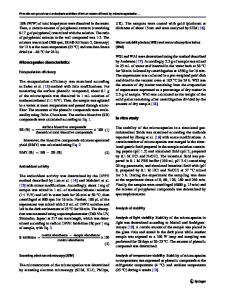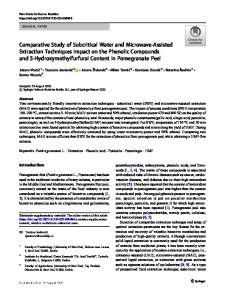Enzyme-assisted extraction of carotenoids and phenolic compounds from sunflower wastes using green solvents
- PDF / 1,554,768 Bytes
- 11 Pages / 595.276 x 790.866 pts Page_size
- 10 Downloads / 329 Views
ORIGINAL ARTICLE
Enzyme‑assisted extraction of carotenoids and phenolic compounds from sunflower wastes using green solvents Gabriella N. Ricarte1 · Maria Alice Z. Coelho1 · Isabel M. Marrucho2 · Bernardo Dias Ribeiro1 Received: 8 October 2019 / Accepted: 12 August 2020 © King Abdulaziz City for Science and Technology 2020
Abstract The aim of this work is to develop an optimized enzymatic assisted extraction methodology to extract carotenoids and phenolic compounds from sunflower wastes (petals and florets) using natural hydrophobic green solvents. Several natural green hydrophobic solvents were used as well as natural hydrophobic eutectic solvents composed of d,l-menthol and different acids, with different hydrophobicity. The multi-enzyme complex V iscozyme® was used to disrupt the cell wall of petals and disc florets. The extracted carotenoids content into the hydrophobic phase was quantified using UV–Vis spectrophotometry and the carotenoids profile was studied using high-performance liquid and thin layer chromatography. The amount of total sugars in the aqueous phase was also analyzed using the dinitrosalicylic acid (DNS) method to infer about the enzymatic action in cell wall. Phenolic compounds also in the aqueous phase were analyzed by Folin Denis method. The eutectic solvent d,l-menthol:d,l-lactic acid (M:HLac) (1:2) was the best solvent for extraction of carotenoids from sunflower wastes, with 147 ppm of carotenoids extracted, in comparison to 115 ppm obtained with the standard solvent, n-hexane. In what concerns phenolic compounds, M:HLac was again better than the standard solvent. The use of the multi-enzyme complex Viscozyme® had different responses, depending on the solvent tested. For the green solvent M:HLac, the enzyme improved the carotenoids extraction, achieving 335 ppm of carotenoids in the extract. The role of enzyme, solvent, water and sunflower quantity in the carotenoid extraction was evaluated and optimized through a central composite rotatable design (CCRD), using the M:HLac as solvent. According to the analysis of CCRD, the most efficient extractions were carried out using more solvent and less raw material, whose best result reached 1449 mg carotenoids/100 g biomass ppm of carotenoids. This work emphasizes the possibility of developing more sustainable enzyme-assisted separation processes, through the substitution of toxic solvents with natural, environmentally friendly, solvents. Keywords Carotenoids · Extraction · Eutectic solvents · Lutein · Sunflower petals
Introduction Sunflower (Helianthus annuus L., Compositae family) is an oilseed crop that shows high adaptability, resistance to dry periods and high grain/oil yield. Sunflower seeds are widely used in human nutrition due to their high content of lipids, proteins and bioactive compounds, including tannins, saponins, alkaloids, phenolic compounds and phytosterols. * Bernardo Dias Ribeiro [email protected] 1
Escola de Química, Universidade Federal do Rio de Janeiro, Rio de Janeiro, RJ 21941‑598, Brazil
Centro de Quí
Data Loading...











